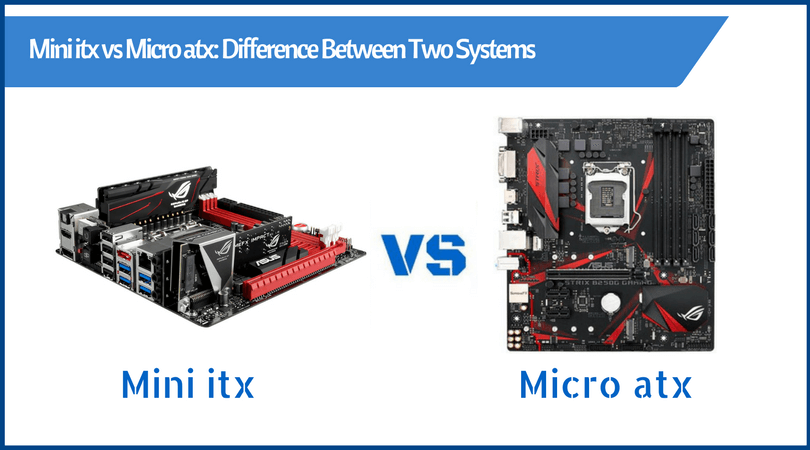You have a top quality monitor and other peripherals to make a most suitable computing system, but do you know that the size and performance of a motherboard (which actually is a brain of a PC) matter the most? Undoubtedly, a well-built board can help to boost the performance of your system in a great way.
If you are confused about the kind of motherboards to get for your small system, you have come to the right place. These days we hear a lot about the different systems like Mini ITX, Micro ATX, etc. Are these the same thing? What are their differences? How can you choose? To clarify these questions and more, this article will explain in detail the differences between the small form factor motherboards Micro ATX vs Mini ITX. First, let’s start with what these terms mean.
What are small form factor motherboards?
Any motherboard which is below a standard size is called a small form factor motherboard. Usually, such motherboards are used in devices that are smaller than your average laptop, mainly small devices like hand-held computers and tablets. Some more devices where you can use such kind of motherboards are- smartphones, home theater systems, digital video cameras, and much more.
Advantages and Disadvantages of such motherboards?
They have a lot of advantages, but for starters, they are simpler and more affordable. Other than that, they are also easier to assemble and manage by everyone. They provide for more comfortable customization and so are very popular with people who wish to make their own motherboards, and by extension, their personal computers.
However, their small size also gives them a few disadvantages. These boards may or may not perform as efficiently as regular motherboards. Also, because of its smaller size, there is much less space to attach components and electrical layouts.
Micro ATX
This is one of the most popular kinds of small form factor motherboard available in the market today. Physically this motherboard is bigger than its counterpart, Mini ITX. It also has many features, listed below-
- There are 3 sizes available in these boards- standard, minimum, and maximum, each with its own physical size. The minimum is the smallest size among the three, and the standard is the largest.
- These boards can provide support to CPUs from major brands like Intel, AMD, and more. This allows you greater customization in the Micro ATX board.
- They are backward compatible with the ATX motherboard, making it more mainstream to use.
- These boards come with a complete range of peripherals that are integrated into the board. These peripherals are usually available only in full-size motherboards, for example- audio, graphics, Ethernet, etc.
Mini ITX
This is the other popular variety of small form factor motherboard that is rising in popularity in the market today. Some features of this motherboard are-
- This kind of motherboard is only available in a fixed size, which is significantly smaller than Micro ATX.
- The main reason for developing this kind of motherboard is to support computers in small spaces at a low cost. Usually, these boards are used in cars, network boxes, set-up boxes, and more.
- Its main advantages are its small size, its low power consumption, and little noise.
- No specialized components are required for these boards, and they can hold an insufficient number of elements and layouts.
Mini itx vs Micro atx
Based on the features listed above, we have created the following comparison of Mini ITX vs Micro ATX for easier understanding of which would suit you best:
Mini itx Vs micro atx Size: Based on an overlook, it might be said that since Mini ITX is smaller, it would be cheaper. However, there are a lot of other factors involved, like the form factor of the power supply used by the Mini ITX boards. The form factor is not readily available, with the good ones being costly. That increases the costs of these boards in the long run. In comparison, Micro ATX boards are available for a lower price and have no hidden factors to consider. Therefore, Micro ATX boards are definitely more value for money.
Based on Performance: Micro ATX vs Mini ATX don’t put on a tough fight when it comes to performance. Micro ATX boards are known to give you the performance expected from a full-size motherboard. Also, Micro ATX boards have a lot of potential for growth down the line, while Mini ITX has a minimal scope of growth. Another considerable advantage of Micro ATX boards in this perspective is it can add cooling technologies to itself if required, giving your system greater clocking speeds. This feature cannot be available in the Mini ITX boards. Micro ATX boards undoubtedly give you more value in terms of performance.
Based on Upgradability: Many users wish to have the flexibility to upgrade their systems in the future. Mini ITX boards have very little promise when it comes to upgradability, with only 2 RAM slots, and 1 video card slot. On the other hand, Micro ATX boards have many more upgrade options, with 4 RAM slots, 2 video card slots, and USB 3.0 slots where you can install a sound card or a wireless adapter. Micro ATX boards are apparently the better choice for any user who wishes to upgrade in the future.
In general, we can safely say that Micro ATX boards give you better features at more value for money. If features like performance or future upgrading options bow out before easing of transportation and low power consumption, then Mini ITX boards should be your choice. For every other case, Micro ATX is the better choice for you.

